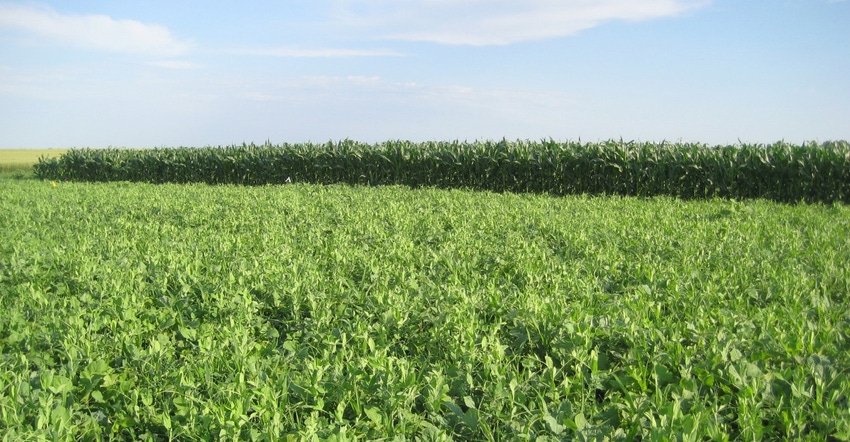
As part of USDA’s Pandemic Assistance for Producers Program, the agency is introducing the Pandemic Cover Crop Program to allow producers who insured their spring crop and planted cover crops during the 2021 crop year to become eligible for a premium benefit. All cover crops reportable to the Farm Service Agency are eligible and the premium support is $5 per acre, but no more than the full premium owed. Producers must file a report of acreage form by June 15 to qualify for the premium reduction.
The PCCP offered by USDA’s Risk Management Agency helps farmers maintain their cover crop systems, despite the financial challenges posed by the pandemic. The PCCP is part of USDA’s Pandemic Assistance for Producers initiative, a bundle of programs to bring financial assistance to farmers, ranchers and producers who felt the impact of COVID-19 market disruptions.
“Cultivating cover crops requires a sustained, long-term investment, and the economic challenges of the pandemic made it financially challenging for many producers to maintain cover crop systems,” says RMA Acting Administrator Richard Flournoy. “Producers use cover crops to improve soil health and gain other agronomic benefits, and this program will reduce producers’ overall premium bill to help ensure producers can continue this climates-smart agricultural practice.”
PCCP provides premium support to producers who insured their spring crop with most insurance policies and planted a qualifying cover crop during the 2021 crop year.
Illinois, Indiana and Iowa have existing programs for producers to receive a premium benefit for planting cover crops. In these states, participating producers will receive an additional benefit.
All cover crops reportable to FSA are eligible and include cereals and other grasses, legumes, brassicas and other non-legume broadleaves, and mixtures of two or more cover crop species planted at the same time.
Crop insurance barriers
Robert Myers, Midwest Regional SARE Coordinator at the University of Missouri, recently detailed in a blog for AGree some of the research insights on how crop insurance impacts on-farm conservation practices.
He notes the National Cover Crop Farmer Survey has included several questions over the years about farmer perceptions of crop insurance barriers in terms of cover crops. For example, the 2017-18 survey asked whether perceived issues with crop insurance was impacting farmer adoption; a sizeable fraction of farmers, 30%, reported that they perceived crop insurance to be a barrier to cover crop adoption.
A recent graduate student study (Fleckenstein et al., 2020) majority of farmers who participated in the Iowa, Illinois and Indiana pilots who have already adopted conservation practices said they have been little impacted by crop insurance. Myers says those who had the perception that crop insurance is hindering adoption is not insignificant.
“The 26% who said that they perceived that crop insurance IS limiting cover crop adoption would translate to over 100,000 soybean and corn producers who are not as likely to adopt cover crops because of crop insurance concerns,” Myers wrote.
Myers notes, “If federal crop insurance policies could be updated to reflect the risk-reducing impacts of soil health on yield, we could have a program where reduced insurance premiums provide a financial incentive for adopting soil health practices.”
“Cover crops are essential for holding the soil and improving its water retention,” says National Association of Conservation Districts President Michael Crowder. “NACD applauds USDA for bolstering payments for these important practices to incentivize further adoption. The PCCP program recognizes early adopters and producers who prioritize soil health management systems.”
Program details
To receive the benefit for this program, producers must file a Report of Acreage form (FSA-578) for cover crops with USDA’s Farm Service Agency (FSA) by June 15, 2021, which is distinct from the normal acreage reporting date. The normal acreage reporting deadline with FSA has not changed, but to receive the premium benefit, producers must file by June 15. The cover crop fields reported on the Report of Acreage form must match what the producer reported to their insurance company for crop insurance policies. To file the form, producers must contact and make an appointment with their local USDA Service Center.
Certain policies are not eligible because they have underlying coverage, which would already receive the benefit or are not designed to be reported in a manner consistent with the Report of Acreage form (FSA-578). PCCP is not available for Whole-Farm Revenue Protection, Enhanced Coverage Option, Hurricane Insurance Protection – Wind Index, and Supplemental Coverage Option. Stacked Income Protection (STAX) and Margin Protection (MP) policies are only eligible for PCCP when insured as a standalone policy. STAX and MP endorsements to underlying policies are not eligible for PCCP.
PCCP does not change acreage reporting dates, reporting requirements, or any other terms of the crop insurance policy.
Conservation practice standard for cover crops
Meanwhile, USDA’s Natural Resources Conservation Service has made the determination not to update its conservation practice standard for cover crops. NRCS originally proposed restricting mechanical harvest of cover crops, but after reviewing input from agricultural producers and groups, NRCS recognizes this could present challenges for producers who use this important conservation practice.
Crowder notes NACD is also pleased by NRCS’s decision not to modify cover crop practice standards. “These forward-thinking decisions by USDA will have lasting impacts to increase cover crop adoption across the U.S.,” he says.
The latest version of the conservation practice standard can be found in the Field Office Technical Guide under Section IV, Conservation Practices and Supporting Documents, by State.
Read more about:
Federal Crop Insurance ProgramAbout the Author(s)
You May Also Like






